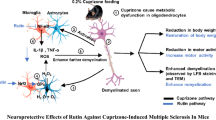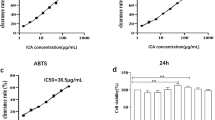Abstract
The cuprizone (CPZ)-induced toxic demyelinating model, characterized by the degeneration of oligodendrocytes, has been utilized to study multiple sclerosis-related lesions. The present study was designed to determine the effect of epimedium flavonoids (EF), the main component extracted from Epimedium sagittatum, on CPZ-induced neuropathological changes in the corpus callosum of C57BL/6 mice. Once we determined an EF-based protective effect on the corpus callosum, we sought to explore the underlying mechanism of this protection. To induce demyelination, 8-week-old mice were fed with 0.2 % CPZ for a maximum period of 6 weeks. EF treatment for a period of 3 weeks effectively decreased the breakdown of myelin, OL loss, and oligodendrocyte precursor cell accumulation in CPZ-fed mice. In addition, EF administration significantly increased the cortical expression level of insulin-like growth factor 1 (IGF-1). This study provides the first in vivo evidence of EF-based protection against CPZ-induced neuropathological changes. Furthermore, our study suggests that upregulated IGF-1 may play a role in this protection.





Similar content being viewed by others
References
Kipp M, Clarner T, Dang J, Copray S, Beyer C (2009) The cuprizone animal model: new insights into an old story. Acta Neuropathol 118:723–736
Yin LL, Lin LL, Zhang L, Li L (2012) Epimedium flavonoids ameliorate experimental autoimmune encephalomyelitis in rats by modulating neuroinflammatory and neurotrophic responses. Neuropharmacology 63:851–862
Skripuletz T, Bussmann JH, Gudi V, Koutsoudaki PN, Pul R, Moharregh-Khiabani D, Lindner M, Stangel M (2010) Cerebellar cortical demyelination in the murine cuprizone model. Brain Pathol 20:301–312
Yang HJ, Wang H, Zhang Y, Xiao L, Clough RW, Browning R, Li XM, Xu H (2009) Region-specific susceptibilities to cuprizone-induced lesions in the mouse forebrain: implications for the pathophysiology of schizophrenia. Brain Res 1270:121–130
Morell P, Barrett CV, Mason JL, Toews AD, Hostettler JD, Knapp GW, Matsushima GK (1998) Gene expression in brain during cuprizone-induced demyelination and remyelination. Mol Cell Neurosci 12:220–227
Lindner M, Fokuhl J, Linsmeier F, Trebst C, Stangel M (2009) Chronic toxic demyelination in the central nervous system leads to axonal damage despite remyelination. Neurosci Lett 453:120–125
García-Segura LM, Dueñas M, Fernandez-Galaz MC, Chowen JA, Argente J, Naftolin F, Torres-Aleman I (1996) Interaction of the signalling pathways of insulin-like growth factor-I and sex steroids in the neuroendocrine hypothalamus. Horm Res 46:160–164
D’Ercole AJ, Ye P, Calikoglu AS, Gutierrez-Ospina G (1996) The role of the insulin-like growth factors in the central nervous system. Mol Neurobiol 13:227–255
Mason JL, Ye P, Suzuki K, D’Ercole AJ, Matsushima GK (2000) Insulin-like growth factor-1 inhibits mature oligodendrocyte apoptosis during primary demyelination. J Neurosci 20:5703–5708
Komoly S, Hudson LD, Webster HD, Bondy CA (1992) Insulin-like growth factor I gene expression is induced in astrocytes during experimental demyelination. Proc Natl Acad Sci USA 89:1894–1898
Voss EV, Škuljec J, Gudi V, Skripuletz T, Pul R, Trebst C, Stangel M (2012) Characterisation of microglia during de- and remyelination: can they create a repair promoting environment? Neurobiol Dis 45:519–528
Torkildsen O, Brunborg LA, Myhr KM, Bø L (2008) The cuprizone model for demyelination. Acta Neurol Scand 188(Suppl):72–76
Benetti F, Ventura M, Salmini B, Ceola S, Carbonera D, Mammi S, Zitolo A, D’Angelo P, Urso E, Maffia M, Salvato B, Spisni E (2010) Cuprizone neurotoxicity, copper deficiency and neurodegeneration. Neurotoxicology 31:509–517
Franco-Pons N, Torrente M, Colomina MT, Vilella E (2007) Behavioral deficits in the cuprizone-induced murine model of demyelination/remyelination. Toxicol Lett 169:205–213
Matsushima GK, Morell P (2001) The neurotoxicant, cuprizone, as a model to study demyelination and remyelination in the central nervous system. Brain Pathol 11:107–116
Armstrong RC, Le TQ, Flint NC, Vana AC, Zhou YX (2006) Endogenous cell repair of chronic demyelination. J Neuropathol Exp Neurol 65:245–256
Acs P, Kalman B (2012) Pathogenesis of multiple sclerosis: what can we learn from the cuprizone model. Methods Mol Biol 900:403–431
Wang H, Li C, Wang H, Mei F, Liu Z, Shen HY, Xiao L (2013) Cuprizone-induced demyelination in mice: age-related vulnerability and exploratory behavior deficit. Neurosci Bull 29:251–259
Zhang H, Zhang Y, Xu H, Wang L, Adilijiang A, Wang J, Hartle K, Zhang Z, Zhang D, Tan Q, Kong J, Huang Q, Li XM (2014) Olanzapine ameliorates neuropathological changes and increases IGF-1 expression in frontal cortex of C57BL/6 mice exposed to cuprizone. Psychiatry Res 216:438–445
Acs P, Kipp M, Norkute A, Johann S, Clarner T, Braun A, Berente Z, Komoly S, Beyer C (2009) 17β-estradiol and progesterone prevent cuprizone provoked demyelination of corpus callosum in male mice. Glia 57:807–814
Mason JL, Jones JJ, Taniike M, Morell P, Suzuki K, Matsushima GK (2000) Mature oligodendrocyte apoptosis precedes IGF-1 production and oligodendrocyte progenitor accumulation and differentiation during demyelination/remyelination. J Neurosci Res 61:251–262
Tansey FA, Cammer W (1991) A pi form of glutathione-S-transferase is a myelin- and oligodendrocyte-associated enzyme in mouse brain. J Neurochem 57:95–102
Zhang Y, Zhang H, Wang L, Jiang W, Xu H, Xiao L, Bi X, Wang J, Zhu S, Zhang R, He J, Tan Q, Zhang D, Kong J, Li XM (2012) Quetiapine enhances oligodendrocyte regeneration and myelin repair after cuprizone-induced demyelination. Schizophr Res 138:8–17
Cho KH, Kim MW, Kim SU (1997) Tissue culture model of Krabbe’s disease: psychosine cytotoxicity in rat oligodendrocyte culture. Dev Neurosci 19:321–327
Kumar S, Biancotti JC, Yamaguchi M, de Vellis J (2007) Combination of growth factors enhances remyelination in a cuprizone-induced demyelination mouse model. Neurochem Res 32:783–797
Espinosa-Jeffrey A, Zhao P, Awosika W, Wu N, Macias F, Cepeda C, Levine M, de Vellis J (2006) Activation, proliferation and commitment of endogenous stem/progenitor cells to the oligodendrocyte lineage by TS1 in a rat model of dysmyelination. Dev Neurosci 28:488–498
Acknowledgments
This work was supported by the National Natural Science Foundation of China (Nos. 81001656, 81341088), Beijing Nova Star Program in Science and Technology (No. Z12111000250000), Capital Medical Development Special Program (No. 2011-1001-06), and the Beijing Organization Department of the Municipal Party Committee Project for Highly Talented Men (2012D005018000010).
Conflict of interest
The authors declare that they have no competing interests.
Author information
Authors and Affiliations
Corresponding authors
Electronic supplementary material
Below is the link to the electronic supplementary material.
Rights and permissions
About this article
Cite this article
Liang, M., Chen, Y., Zhang, L. et al. Epimedium Flavonoids Ameliorate Neuropathological Changes and Increases IGF-1 Expression in C57BL/6 Mice Exposed to Cuprizone. Neurochem Res 40, 492–500 (2015). https://doi.org/10.1007/s11064-014-1490-0
Received:
Revised:
Accepted:
Published:
Issue Date:
DOI: https://doi.org/10.1007/s11064-014-1490-0




